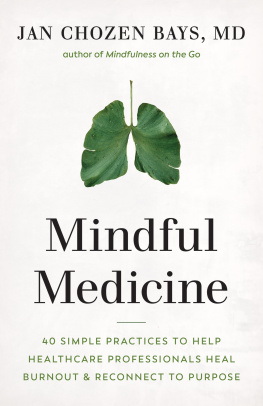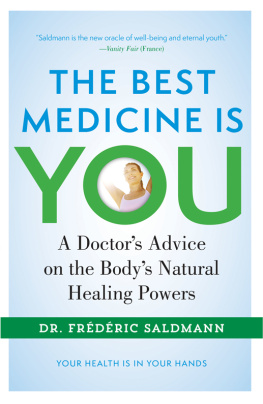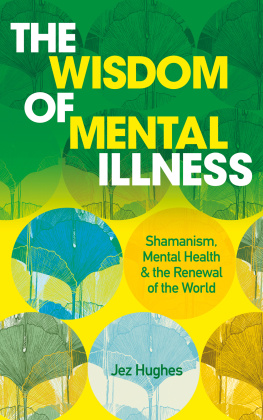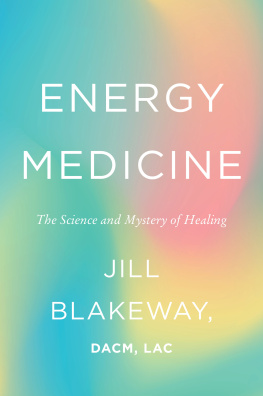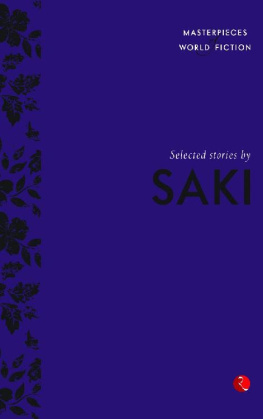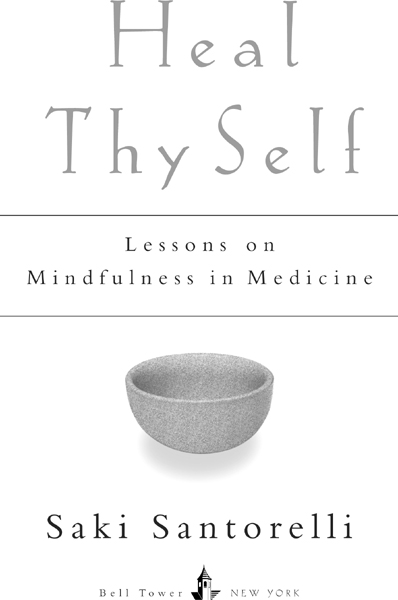Saki Santorellis words have the gentle strength of a birds wings, beating softly as they gradually bear us aloft. Brave, beautiful, and disturbing, his book reminds us of the healing that conventional Western medicine has all but forgotten. I wish it had been available when I was in medical school.
M ARK E PSTEIN, M.D., author of
Going to Pieces Without Falling Apart
In prose, poetry, and poignant case examples, Saki evokes for us the mutuality of the healing relationship and reclaims for medicine and all who work within it the wisdom and power of its lineage. Heal Thy Self is a clear mirror in which we can find that freedom which is at the heart of all authentic healing and through it reconsecrate ourselves to our work and to our lives.
R ACHEL N AOMI R EMEN, M.D.,
author of Kitchen Table Wisdom
A simply beautiful book. A full body/mind/heart contact between that which is healing within and that, a bit further in, which promotes that healing. A most necessary book for any medical student or healing library.
S TEPHEN L EVINE, author of A Year to Live
This is a remarkable, helpful book. Its genuine and warmhearted teaching gives us a real glimpse of the path of healing. Recommended to everyone, new or old, on the path of life.
C HARLOTTE J OKO B ECK, author of Everyday Zen
Saki Santorelli shows the fruit of his dedicated effort in presenting mindfulness as not just the stuff of meditation retreats and stress reduction seminars. His accounts of everything from counseling a depressed woman to watching his six-year-old daughter encounter a homeless person bring the reader up against basic truths of our lives. It is honest, clear, and very helpful.
S HARON S ALZBERG, author of A Heart as Wide as the World
Contents
Part One
Part Two
Part Three
Part Four
Information about the Center for Mindfulness
in Medicine, Health Care, and Society
Acknowledgments
R ECOGNITION OF THE interdependent nature of our existence is easily overlooked in the press of everyday life. In my attempts to honor the actuality of this interconnectedness, writing these acknowledgments has been instructional, a powerful reminder to me of the scores of people who have contributed directly and indirectly to this book. I wish to bow to the force of their presence in my life.
I thank Jon Kabat-Zinn, Ph.D., the founder of the Stress Reduction Clinic and the executive director of the Center for Mindfulness in Medicine, Health Care, and Society at the University of Massachusetts Medical School. Since 1981, he has been my boss, mentor, colleague, teaching partner, and most fundamentally a friend and fellow companion on the inner journey from which this book has arisen. Trained in both the basic and contemplative sciences, his commitment to the joining of inner and outer, spirit and matter, form and formlessness, has had a profound effect in my life and in the worlds of medicine and health care. For his vision, wisdom, wit, and friendship, I am forever grateful.
I wish to thank Judith K. Ockene, Ph.D., director of the division of Preventive and Behavioral Medicine in the Department of Medicine at the University of Massachusetts Medical School, for her encouragement and open-mindedness. I have learned much from her during the last fifteen years and she has given me ample room to grow into what is mine to do.
I thank the 1,400 physicians in central Massachusetts and the surrounding New England region who have referred their patients to the Stress Reduction Clinic and the far smaller cadre of these physicians with whom I work more closely at UMass Memorial Health Care. In particular, I wish to express my gratitude to John Moynahan, M.D.; John Zawacki, M.D.; Sarah Stone, M.D.; David Clive, M.D.; Ira Ockene, M.D.; David Giansiracusa, M.D.; David Hatem, M.D.; Ed Landeau, M.D.; Andy Cohen, M.D.; Ilia Shlimak, M.D.; Bill Damon, M.D.; Lynn Manfred, M.D.; and Mai-Lan Rogoff, M.D. Their dedication to educating the next generation of physicians, to engaging in patient-centered care, and going the extra mile in the service of those whom they serve remains for me a wellspring of inspiration and a quiet source of pride. In addition, I wish to express my gratitude to Marty Young, Ph.D.; Majorie Clay, Ph.D.; Michael Wertheimer, M.D.; and H. Brownell Wheeler, M.D., for their presence and support.
My teaching colleagues in the Stress Reduction Clinic have been unflagging sources of inspiration and encouragement. I cannot imagine a finer group of people to work with. I wish to thank Ferris Urbanowski, M.A., for her unbounded radiance and her enthusiasm and willingness to read and reread drafts of the manuscriptand, most of all, for her unwavering attention to and insights about the relational aspects of mindfulness and the healing encounter. I thank Elana Rosenbaum, L.I.C.S.W., for her huge heart, undying courage, and capacity to stand inside the truth of her own experience; Pamela Erdmann, M.Ed., for her honesty, integrity, and dedication to teaching mindfulness in the Massachusetts prison system; Florence Meyer, M.A., M.S., for her listening, her embodiment of spaciousness and safety so beautifully evidenced in the classroom, and for her detailed feedback about an early draft of the manuscript; Melissa Blacker for the depth of her Zen practice and its sensitive, playful expression in her work; Fernando de Torrijos for his compassionate heart, gentlemanly manner, and breadth of knowledge about the contemplative traditions, and more so, for he and Melissas shared commitment to bringing the heart of mindfulness practice to low-income, medically underserved, inner-city residents in Worcester, Massachusetts.
My deep appreciation goes to Larry Horwitz, M.B.A., for his dharmically oriented organizational acumen and for our evolving friendship; to Anne Skillings, M.S., for her quick mind, longstanding attention to our research, and capacity to skillfully play a hundred roles; to Leigh Emery, R.N., M.S., for her administrative vision and the richness of her poetry; and to Michael Bratt, Ph.D., for his enthusiasm for mindfulness practice, his dedication to the clinics research endeavors, and his capacity to bring together a research team. I give thanks to Carol Lewis, Sylvia Ciarlo, Roberta Lewis, Leslie Lynch, Norma Rosiello, and, most recently, Jean Baril and Carmen Torres for taking responsibility for the day-today operation of the clinic while actively participating in shaping the unfolding vision of the Center for Mindfulness in Medicine, Health Care, and Society.
This book would not have been possible without the ten thousand patients who have participated in the Stress Reduction Clinic since 1979 and who decided to roll up their sleeves and take up the practice of mindfulness as a way of learning to work with stress, pain, and illness. Their presence in my life has been nothing short of transformative. I pray that I have done them justice in attempting to capture the actuality of their lives and their efforts.


